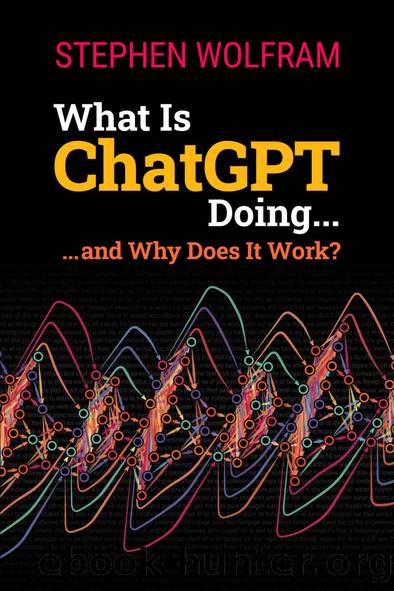What Is ChatGPT Doing ... and Why Does It Work? by Stephen Wolfram

Author:Stephen Wolfram [Wolfram, Stephen]
Language: eng
Format: azw3, epub, mobi
Publisher: Wolfram Media, Inc.
Published: 2023-03-10T00:00:00+00:00
The input is a vector of n tokens (represented as in the previous section by integers from 1 to about 50,000). Each of these tokens is converted (by a single-layer neural net ) into an embedding vector (of length 768 for GPT-2 and 12,288 for ChatGPTâs GPT-3). Meanwhile, thereâs a âsecondary pathwayâ that takes the sequence of (integer) positions for the tokens, and from these integers creates another embedding vector. And finally the embedding vectors from the token value and the token position are added together âto produce the final sequence of embedding vectors from the embedding module.
Why does one just add the token-value and token-position embedding vectors together? I donât think thereâs any particular science to this. Itâs just that various different things have been tried, and this is one that seems to work. And itâs part of the lore of neural nets thatâin some senseâso long as the setup one has is âroughly rightâ itâs usually possible to home in on details just by doing sufficient training, without ever really needing to âunderstand at an engineering levelâ quite how the neural net has ended up configuring itself.
Hereâs what the embedding module does, operating on the string hello hello hello hello hello hello hello hello hello hello bye bye bye bye bye bye bye bye bye bye :
Download
What Is ChatGPT Doing ... and Why Does It Work? by Stephen Wolfram.epub
What Is ChatGPT Doing ... and Why Does It Work? by Stephen Wolfram.mobi
This site does not store any files on its server. We only index and link to content provided by other sites. Please contact the content providers to delete copyright contents if any and email us, we'll remove relevant links or contents immediately.
Management Strategies for the Cloud Revolution: How Cloud Computing Is Transforming Business and Why You Can't Afford to Be Left Behind by Charles Babcock(4127)
Ego Is the Enemy by Ryan Holiday(3982)
Offensive Shellcode from Scratch by Rishalin Pillay(3620)
Exploring Deepfakes by Bryan Lyon and Matt Tora(3182)
Robo-Advisor with Python by Aki Ranin(2954)
Learning C# by Developing Games with Unity 2021 by Harrison Ferrone(2839)
Speed Up Your Python with Rust by Maxwell Flitton(2831)
Liar's Poker by Michael Lewis(2806)
Linux Command Line and Shell Scripting Techniques by Vedran Dakic and Jasmin Redzepagic(2784)
Agile Security Operations by Hinne Hettema(2782)
OPNsense Beginner to Professional by Julio Cesar Bueno de Camargo(2780)
Extreme DAX by Michiel Rozema & Henk Vlootman(2777)
Essential Cryptography for JavaScript Developers by Alessandro Segala(2717)
Elevating React Web Development with Gatsby by Samuel Larsen-Disney(2710)
AI-Powered Commerce by Andy Pandharikar & Frederik Bussler(2628)
Python for ArcGIS Pro by Silas Toms Bill Parker(2622)
Cryptography Algorithms by Massimo Bertaccini(2614)
Distributed .NET with Microsoft Orleans by Bhupesh Guptha Muthiyalu Suneel Kumar Kunani(2609)
Incident Response Techniques for Ransomware Attacks by Oleg Skulkin(2608)
